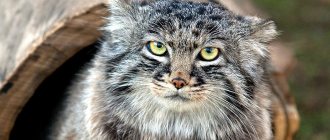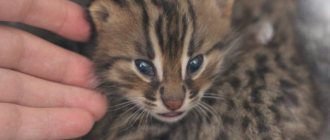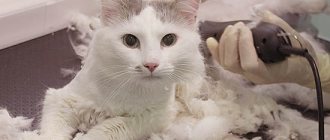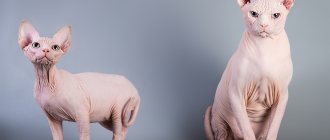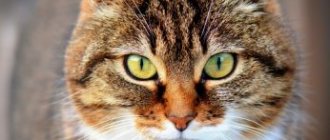Despite its similarity to a domestic cat, the caracal cat is a wild animal. Representatives of the genus of caracals, which includes one species (Caracal caracal) and nine subspecies, distributed in different regions of Africa and Asia. African subspecies are very numerous, while the Turkmen one is listed in the Red Book as endangered.
The exotic beauty of the animal and external similarity to the domestic cat contributed to the spread of domesticated caracals as pets.
Species features of caracals
Habitat
The natural habitat of caracals is savannas and semi-deserts. In the desert, it can go further than its close relative, the serval, due to the fact that the caracal is better adapted to do without water.
Lifestyle
Caracals are nocturnal predators. Hunger can force them to hunt and leave the den during daylight hours; this usually happens in winter and early spring.
Caracals live strictly alone. During mating, a cat can be visited by up to three different cats, but then she raises the cubs on her own for up to 3–4 months.
Grown-up kittens leave to find unoccupied territory - caracals are jealous of protecting their hunting grounds. They are usually larger in caracal cats than in cats. Life expectancy is 15–20 years.
Hunting
Caracals hunt stealthily - they track prey and attack when it is at a short distance.
Long-legged and flexible, caracals are excellent jumpers, and their retractable claws help them catch up to several birds from a group in one jump. In addition to birds, they hunt a variety of game - from small gerbils to lambs. A predator that enters the territory of caracals can also become lunch. They can eat a fox or even a small dog.
If possible, the caracal will happily feed on domestic animals - ducks, chickens or kids. Cats eat their prey on the ground, burying the uneaten food in sand and leaves.
Reproduction
Caracals do not have a specific time of year for having offspring. They mate all year round, but mass childbearing occurs in October, November and all winter months. This is due to the fact that from October to February, under natural conditions, Caracal can obtain a sufficient amount of food. This means it will be able to feed its offspring.
To attract the attention of males, the female secretes a significant volume of urine containing pheromones. During mating games, caracals of both sexes make characteristic “coughing” sounds. Mating of one female occurs with several males over the course of several days. At the same time, she gives preference to mobile, large males.
Gestation of kittens in steppe lynxes takes 68-81 days. In a litter, 2 to 4 kittens are born. The Caracal kitten experiences the greatest difficulties in the first month of birth. He faces many dangers from the outside world. To protect the cubs from attacks by other predators, the lynx changes the location of its family almost daily. Drags kittens to a new den. During this period, the only food available to kittens is mother's milk. Kittens will become quite independent 2-3 weeks after birth, but the mother continues to care for them until almost a year. At about the age of 1 year, caracals become sexually mature.
What does a caracal look like?
General silhouette
The caracal is an elegant, elongated animal, strong and graceful. The body is rectangular in shape, the legs are long, and the structure of this cat resembles a miniature lioness. The croup is often higher than the withers because the hind legs are much longer than the front legs. This structure allows you to jump tens of times your own height.
Head
This cat has a round head, an elongated and small muzzle. The most notable part of a caracal is its ears. They themselves are elongated, and visually they are even longer due to the black tassels, which clearly contrast with the overall sandy color of the cat.
In childhood, these decorations stand on end; in adulthood, they hang along the ear. The large, triangular-shaped eyes are usually light blue or pale green. The black “edge” of dyed wool gives them expressiveness and depth.
Color and coat
The fur of caracals is 3.5–9 cm long, thick, densely packed, and shiny. On the paws, the fur forms brushes that help move along loose desert soils. The color of these cats can vary from light yellow to red-brown. From top to bottom, the color becomes lighter and the coat becomes longer. The belly of caracals is almost white, and the fur is the longest. The black rims of the ears and black whisker pads contrast sharply with the white chin. There are spots and stripes on the inside of the paws that give the animal its individuality.
Origin story
If in Europe and America it is customary to go hunting with dogs, then in Africa and Asia cats were also used for these purposes. In ancient times, richer people tamed cheetahs for hunting, and those who could not afford this chose ocelots or caracals. These cats did an excellent job of catching small antelopes, hares, peacocks and pheasants.
Their name is an interpretation of the Turkish word “karakulak”, literally translated as “black ears”. Caracals were not very resistant to domestication. These animals are smart, like Thai cats, and quite obedient.
Perhaps that is why not so long ago they began to be kept at home not as hunters, but simply as their pets.
It must be said that there are 9 types that the Caracal breed includes. Photos of these animals will tell a layman little. In principle, this is not so important, because the existing varieties have the same descriptions of the nature and features of the maintenance of the house.
Description of the breed
| Breed name: | Caracal |
| Country of origin: | Africa |
| Time of origin of the breed: | 18 century |
| Weight: | 13 – 20 kg |
| EMS code: | – |
| Lifespan: | 12 – 15 years |
| Price of kittens: | 7000 – 9000 $ |
| The most popular nicknames: | list of nicknames for Caracal |
The caracal is a rare animal that is endangered. Its native habitat is the deserts and savannas of Africa, Asia Minor and Central Asia, the Arabian Peninsula and the coast of the Caspian Sea.
Several years ago, the caracal moved from the category of wild predators to a number of exclusive and expensive pets. By purchasing a caracal kitten for your home, you are helping nature preserve one of the species of wild cats.
Today, the caracal is a rare inhabitant of nurseries, and you can only buy a truly purebred kitten that has grown up among people only from an experienced and recognized breeder.
All our breeders are carefully selected from around the world based on genetic and physical characteristics and are 15th generation domesticated, loving people and living in harmony with them.
Breed standard - appearance
There are 9 types of caracal cat, but from the photo a non-specialist will not see the difference between them. All steppe lynxes are tall animals; at the withers, the standard size of an adult caracal reaches 50 cm. However, the steppe lynx cannot be called massive. Caracals are graceful rather than heavy.
- The head of the caracal is elongated. The ears are narrow, long, ending in tufts. The distance between the ears is large. They stand upright. The back of the ears is pure black or streaked with gray.
- The body is short and lean. The tail is shorter than 1/2 of the body.
- Limbs are high and dry. The paws are large.
- The coat is short, red, a mixture of ocher and sandy color or sandy-red without a comb. Lengthened on the belly and chest. Under the eyes there is a yellow stripe of fur.
Character of caracals
Usually tamed cats are gentle. If the kitten was adopted when it was small, or preferably from a tamed mother, and was regularly handled during childhood, then the caracal grows up to be docile and non-aggressive.
Caracals are non-social animals, unsuited to living in groups. These cats fight with their relatives, defending their territory.
Representatives of other species are considered prey and may attack a dog even larger than themselves. In nature, caracals move a lot, therefore even tamed ones are mobile and active. They love to play with various objects, are very smart and learn well.
Caracals willingly communicate with their owners, go on walks together, love to be stroked and scratched, and are not intrusive. Excessive attention tires them and in this case the cat may begin to fight back with its claws and teeth.
Captivity
Caracals are not demanding of conditions, as for a wild predator, but they will require more effort from their owners than a domestic animal.
It is almost impossible to keep these cats in the city. Left unattended, active and playful, they are capable of destroying the entire apartment in a matter of minutes - tearing up furniture, digging up pots and tearing clothes.
The habit of hiding food supplies in secluded corners can cause a lot of trouble in a human home, so an aviary is best suited for keeping a caracal.
How to set up an enclosure for a caracal
An enclosure for a wild cat may not be too large in area, but it must be high, at least 4 meters to the ceiling and deaf. The mesh or lattice needs to be frequent, because the caracal is able to slip into a gap only 7 cm wide. It is advisable to make the floor in the enclosure concrete - it is easier to clean and the caracal will not be able to undermine it. In the enclosure you need to put a house-house and a tree or several branches so that the animal has conditions to climb and jump.
Sterilization
If the animal is not planned for breeding, then sterilization or castration is an excellent way to simplify communication with this predator.
Neutered cats do not try to attract male cats to hunt by leaving “messages” of particularly smelly urine. Neutered cats are more docile and less aggressive.
Other aspects of care
To simplify caring for a caracal, training it to use a tray will help - this will be useful both in an apartment and in an enclosure. Cats' fur does not require special care; they themselves keep it clean.
Seasonal molting of caracals occurs twice a year. During the molting period, it is worth brushing your pet with a thick brush made of natural bristles - this will speed up the change of coat and give it an elegant look.
It is important to monitor the condition of the claws. If they are not worn down enough, you may need to contact your veterinarian for trimming.
Conclusion about the breed
It is quite possible to tame a caracal to live at home, but only if it has been raised and raised in captivity since birth. Like any exotic animal, the domestic caracal requires certain conditions of detention and attention from the owner.
Think about whether you are ready to spend a considerable amount of time and effort on caring for such an unusual animal for the home, to show it care and patience in order to accustom it to the rules established in the house.
Caracal kittens are best trained, but if you take an adult animal, it is unlikely to be so obedient. Caracals should be fed at home with lean beef and sea fish. But don’t forget for a minute that the caracal, although it resembles a harmless kitten, is a predator with whom you should always keep an eye out. [wp-review id=”8568"]
Reviews about the breed
Many cat lovers wonder what breeds of lynx exist that can be kept at home. Particular attention is paid to such a domestic species as the caracal.
The caracal is a domestic lynx that can become an absolutely harmless pet, provided that it grows up in captivity from childhood under the careful care of its owners.
Caracal requires special attention and special conditions for keeping. It will be good if a spacious enclosure is built for the pet animal, where it can walk freely and sharpen its claws.
To do this, you will need to choose a place for an enclosure with a growing tree or, after building it, plant a young tree. Or build a special structure from boards.
Feeding caracals
Caracals are strict predators. They eat only meat and it is impossible to replace it with any other products without harm to health. To best meet the cat's needs, the diet should include carcasses of rodents and birds.
Day-old chicks are sold at poultry farms; they must be given whole, with feathers and bones. In the same form, you can also feed adult birds - chickens, ducks, quails.
A good food for a caracal would be a rabbit (along with its entrails) or rats. These can be purchased at places that sell snake food. It is better to choose beef or lamb that has enough bones and membranes. Feeding the pulp alone may cause diarrhea.
You can treat the caracal with dry food or a piece of cheese, but you cannot feed the cat only with them.
These cats usually digest milk poorly. Caracals drink little; they get enough moisture from raw meat.
They do not need constant access to water, but they should be offered a drink from time to time.
Population status and conservation
In Africa, especially South Africa, the caracal is quite common and is considered a pest. There is a special culture of caracal hunting: they lure it with devices that imitate the cry of a wounded hare or mouse, and at night they shoot it from under the headlights. In addition, in South Africa, caracals are used to drive away birds (mainly guinea fowl) from the runways of military airfields.
Asian subspecies of caracal are much rarer and are listed in Appendix l of CITES. All other caracal subspecies are listed in Appendix II of CITES.
Where can I buy
It is best to buy caracals in specialized nurseries, where they are bred tame. There you can see how the parents behave, how they get along with people, and look at the relatives of the future pet.
Kittens from nurseries are usually litter box trained and accustomed to handling and interacting with humans.
Zoos sometimes also sell caracals, but such cats most often view humans not as an owner or friend, but as a source of food. It is very difficult to instill discipline in such animals.
You should not buy animals that have been caught in the wild - they are more difficult to tame than those born and raised near people.
What to look for when buying a kitten
Before choosing the kitten itself, you need to look at its parents and other adult relatives.
This will help you get an idea of what he will look like as an adult and what his character will be like. Ask the breeders what the cats eat and whether the parents have had any illnesses.
Each kitten must have a veterinary passport with stamps from the state veterinary clinic on vaccinations against at least rabies and panleukemia. Without the stamp, state vaccination clinics are not valid!
A healthy little caracal should have:
- shiny wool;
- clear eyes without streaks or tears;
- dry nose without discharge;
- clean “pants” on the hind legs and a place under the tail.
Ask the breeders to show how the kitten plays, allows itself to be brushed, and has its ears or paws examined.
A resistant and unplayful animal is much more difficult to tame. If the cat is offered sterilized, it is worth finding out who performed the operation.
If one caracal is offered for sale, ask for documents about its origin. The purchase and sale of Red Book species, which include the Turkmen subspecies of caracal, is prohibited by law.
How much does a caracal cost?
Having your own predator is not a cheap pleasure. Prices for domesticated caracals in nurseries start at $6,500 for a neutered kitten. Animals suitable for breeding will be even more expensive.
Sometimes they offer to buy cheaper cats. These may be untamed caracals caught in Africa or Asia, and they will require much more effort to train. Such animals are dangerous because they can carry exotic diseases.
Why are steppe lynxes kept at home?
Man has been taming Caracals for a long time - with them he has adapted to hunt large animals. Today, the domestic caracal is elegant and tame. Rather, it is a means of declaring wealth, an indicator of luxury and a kind of home decoration. Keeping such an exotic cat is prestigious and expensive.
In addition, the steppe lynx is very unpretentious. If you initially tame and train it correctly, the animal will be affectionate and peaceful towards its owners.


